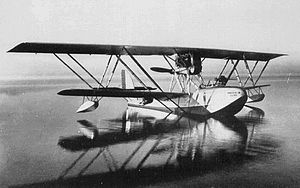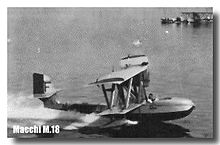
Aermacchi was an Italian aircraft manufacturer. Formerly known as Aeronautica Macchi, the company was founded in 1912 by Giulio Macchi at Varese in north-western Lombardy as Nieuport-Macchi, to build Nieuport monoplanes under licence for the Italian military. With a factory located on the shores of Lake Varese, the firm originally manufactured a series of Nieuport designs, as well as seaplanes.

The AD Flying Boat was designed by the British Admiralty's Air Department to serve as a patrol aircraft that could operate in conjunction with Royal Navy warships. Intended for use during the First World War, production of the aircraft was terminated as the end of the war came into sight, and the type saw little operational use. A number were repurchased after the end of the war by Supermarine Aviation and rebuilt as civil transports, becoming known as the Supermarine Channel.

The Sopwith 1+1⁄2 Strutter was a British single- or two-seat multi-role biplane aircraft of the First World War. It was the first British two-seat tractor fighter and the first British aircraft to enter service with a synchronised machine gun. It was given the name 1+1⁄2 Strutter because of the long and short cabane struts that supported the top wing. The type was operated by both British air services and was in widespread but lacklustre service with the French Aéronautique Militaire.

The Curtiss Models F made up a family of early flying boats developed in the United States in the years leading up to World War I. Widely produced, Model Fs saw service with the United States Navy under the designations C-2 through C-5, later reclassified to AB-2 through AB-5. Several examples were exported to Russia, and the type was built under license in Italy.

The Potez 452 was a French flying boat designed and built by Potez in response to a French Navy specification for a shipboard reconnaissance machine for use on its battleships and cruisers.
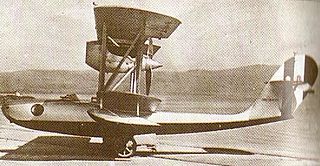
The CANT 25 was an Italian shipboard single-seat sesquiplane flying boat fighter that entered service with the Regia Aeronautica in 1931.

The Macchi L.3, or later Macchi M.3, was an Italian biplane flying boat developed from the earlier L.2.
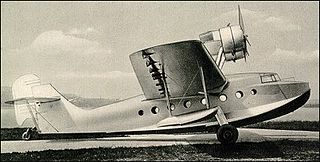
The Macchi M.C.94 was a 1930s Italian commercial flying boat built by Macchi.

The Savoia-Marchetti S.59 was a 1920s Italian reconnaissance/bomber flying boat designed and built by Savoia-Marchetti for the Regia Aeronautica.
The Fokker B.I was a reconnaissance flying boat built in the Netherlands in 1922. The B.I was followed by an improved version, the B.III in 1926. It was a conventional biplane flying boat design, with staggered sesquiplane wings braced by struts arranged as a Warren truss. The engine was mounted pusher-wise on the top wing. The duralumin hull featured three open cockpits - one at the nose for a gunner, one in front of the lower wing for the pilot and engineer and one behind the wings for another gunner. The B.I was amphibious, equipped with main undercarriage that folded back along the hull, but this feature was omitted in the B.III. The B.I was flown in the Dutch East Indies by the Naval Air Service for a number of years, and although it gave good service, no further examples were ordered from Fokker.

The Lohner L was a reconnaissance flying boat produced in Austria-Hungary during World War I. It was a two-bay biplane of typical configuration for the flying boats of the day, with its pusher engine mounted on struts in the interplane gap. The pilot and observer sat side by side in an open cockpit, and both the upper and lower sets of wings featured sweepback.

The Macchi M.5 was an Italian single-seat fighter flying boat designed and built by Nieuport-Macchi at Varese. It was extremely manoeuvrable and agile and matched the land-based aircraft it had to fight.

The Macchi M.7 was an Italian single-seat fighter flying boat designed by Alessandro Tonini and built by Macchi. A modified version of the M.7, the M.7bis won the Schneider Trophy in 1921.

The Latham 43 was a flying boat bomber built in France in the 1920s for service with the French Navy. It was a conventional design for its day - a two-bay biplane with unstaggered wings, and engines mounted tractor-fashion on struts in the interplane gap. The pilot sat in an open cockpit, with a gunner in an open bow position, and another in an open position amidships.
The Macchi M.8 was an Italian reconnaissance/bomber flying boat designed by Alessandro Tonini and built by Macchi. It was used by the Italian Naval Aviation and was later flown by crews from the United States Navy.

The Macchi M.9 was a flying boat bomber designed by Alessandro Tonini and produced by Macchi in Italy close to the end of World War I and shortly afterwards.

The Macchi M.24 was a flying boat designed by Alessandro Tonini and produced by Macchi in Italy during the 1920s. Originally intended as a bomber, it was eventually produced for civilian use as well.
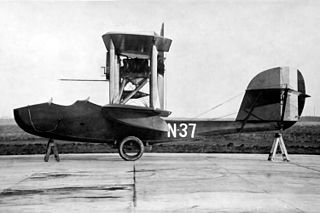
The Norman Thompson N.1B was a prototype British flying boat fighter aircraft of the First World War. A two-seat single-engined pusher biplane, a single example was built in 1917, but no production followed.

The Macchi M.26 was an Italian flying boat fighter prototype of 1924 designed and manufactured by Macchi.

The Macchi M.71 was an Italian flying boat fighter of the 1930s designed and manufactured by Macchi.
